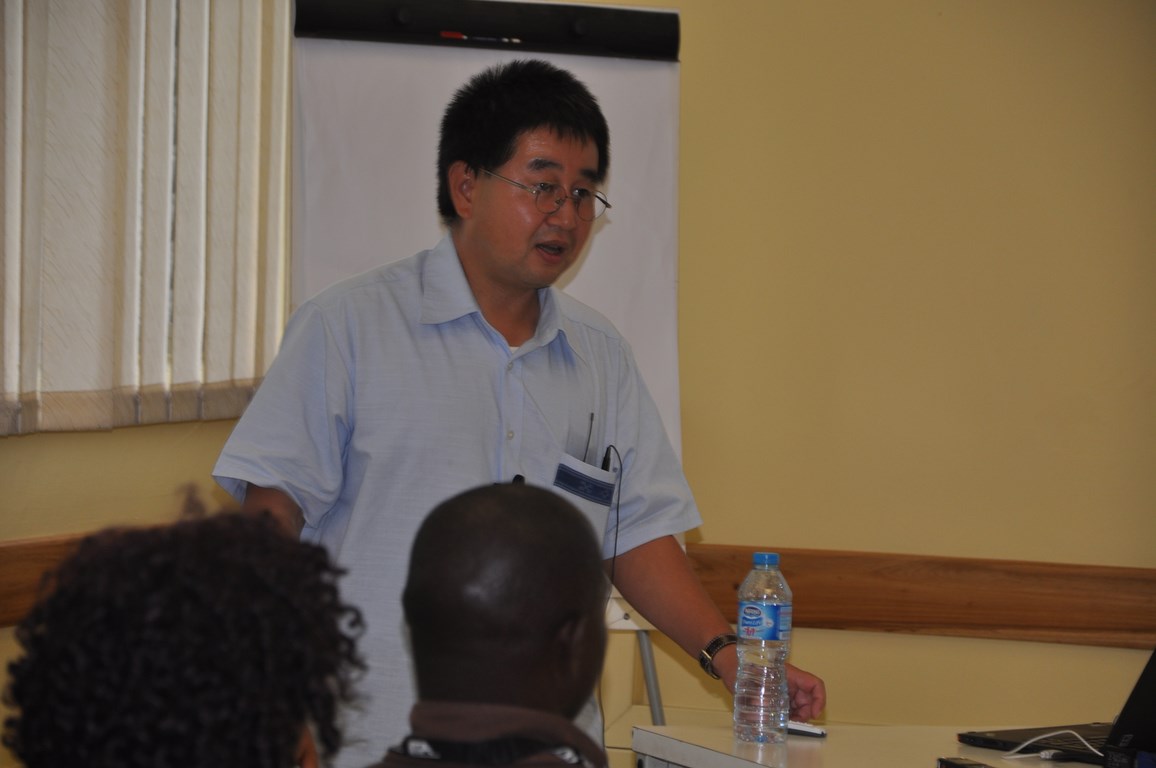Hidehiko Kikuno, a former IITA scientist, visited the Institute recently and gave an overview on yam research and development by the yam research team led by Prof Hironobu Shiwachi at the Tokyo University of Agriculture (TUA) Miyako-subtropical farm in Japan.

Hidehiko Kikuno makes a presentation at IITA about yam research and development at the
Tokyo University of Agriculture, Japan.
IITA has the world mandate on yam research and works with various institutions such as TUA on the advancement of yam for income generation and food security. IITA signed a memorandum of agreement with TUA in 2012 and has facilitated some of its research on yam and capacity building of prospective research scientists from Japan.
At the seminar, Kikuno presented the findings of key exploratory studies on polyploid breeding of water yam (Dioscorea alata), nitrogen fixation in water yam, mechanization of yam propagation, as well as breeding for yam utilization and processing.
Results of the first phase of the exploratory research on polyploidy breeding showed how the physical characteristics of water yam could be enhanced, and thus affect the yield of the tuber. This is a key finding that could contribute to breeding for high yield variety. However, Kikuno indicated that more work needs to be done on agronomic traits such as tuber yield.Yam propagation involves a lot of drudgery and strenuous agronomic practices and at Miyako-jima, researchers are working on eliminating drudgery in yam propagation through mechanization. With funding from the Japan Society for the Promotion of Science (JSPS), researchers have been able to use common tractors for ridging, mulching, and harvesting on yam. Moreover, a popular planting machine for vegetable seedlings was improved and tested for yam vine propagation.
Kikuno also indicated that new varieties of water yam have been selected for mechanized cultivation. Tubers are round in shape and have less root hair. In terms of value addition and utilization, Kikuno reported that researchers and food processors are working together on new yam products such as distilled spirit made from water yam and fresh yam products sold in supermarkets.
“Yam is very important in the Japanese diet,” Kikuno said. Traditionally, Chinese yam (Dioscorea polystachya) or jinenjo (D. japonica) in Japan is served as a vegetable in Asian homes. Regarded as the “medicine of the mountain”, yamaimo’s health benefits are numerous, providing consumers with substantial amounts of carbohydrates, proteins, thiamine, and vitamin C.
In a separate interview, Kikuno, who spearheads progressive yam research at TUA, indicated that the development of the yam value chain in Miyako-Jima, Japan has been going on under an industry-academia or industry-government-academia partnership. “In Miyako-Jima (island), I work closely with farmers, private industry, researchers, and the government to come up with innovations,” Kikuno said. This can also be replicated in Nigeria, the world’s largest producer of yam.
Agricultural developments and innovations are vital to the African economy desperately in need of job creation. Researchers are making breakthroughs across the yam value chain and for these innovations to grow into job-creating commercial products and services investments in industry-academia or industry-government-academia partnerships are needed.

No Comments